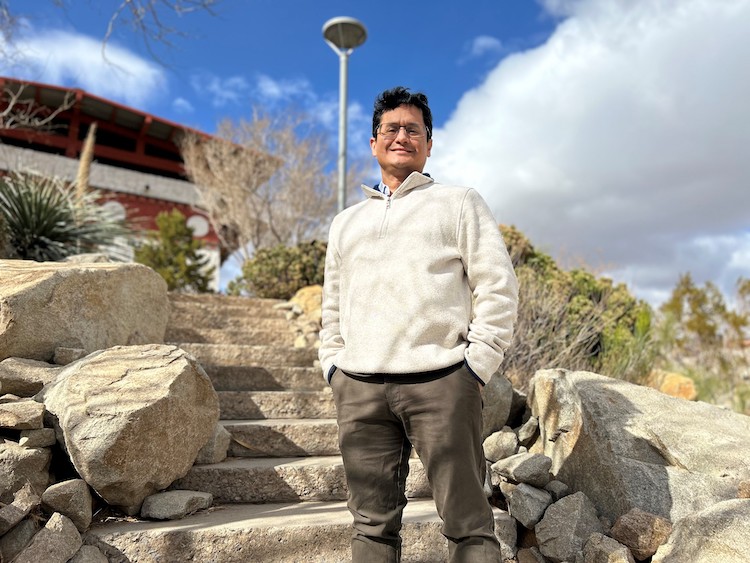
Geology Professor’s Work Recognized by NASA
Teaching NASA astronauts about geology isn’t Jose Hurtado’s first space rodeo. Throughout his career, he’s been within the top 100 candidates for astronaut candidacy and has spent many days in a Multi-Mission Space Exploration Vehicle running tests for NASA, but his true impact has been in helping to train future astronauts.

As a primary trainer and through a detailed curriculum he helped create, Hurtado, Ph.D., teaches astronauts about geology and its relation to planetary sciences – knowledge they’ll need in future spaceflights.
When individuals are selected as NASA astronauts, they undergo two years of rigorous training and schooling to prepare them for spaceflight, which includes topics ranging from medical procedures and science to public speaking and jet piloting. While Hurtado’s work is just one part of the lengthy process, it sets an important foundation for astronauts, who often come from a wide variety of backgrounds, science or otherwise.
“My background as a field geologist has been recognized as something valuable, which is one of the reasons why I’ve been welcomed into the field,” Hurtado said. “Field geology is something that most planetary scientists don’t have a strong background in.”
The geology training takes place over the course of two weeks. The first week consists of classroom work at the Johnson Space Center in Houston, Texas, providing future astronauts with a foundation in geology. The second week involves fieldwork, typically in areas like northern New Mexico or Arizona, where the landscape is similar to that of the moon. While there, astronauts learn in-depth geology topics and practice teamwork and interpersonal communication skills as they camp in close quarters together, an important skill needed for long trips in space.
“A big part of what they do from the International Space Station is Earth observation, so they’ll take pictures of the Earth and review the Earth from space,” Hurtado said. “So part of the philosophy of doing the Earth and planetary science training is to give them an idea of what they’ll be looking at. They need to understand Earth processes and geology.”
As NASA aims to send more astronauts to the moon, Hurtado’s training also plays a critical role in preparing them.
“Dr. Hurtado’s leadership in training NASA astronauts for the moon and Mars demonstrates the high-tech nature of modern geosciences, and how UTEP’s Department of Earth, Environmental and Resource Sciences is on the cutting edge of 21st scientific discovery,” said James Kubicki, Ph.D., chair of UTEP’s Department of Earth, Environmental and Resource Sciences.
In a letter written by NASA Artemis Geology Training Lead, Cynthia Evans, Ph.D., NASA celebrated Hurtado’s work in helping the agency to create a foundation for their introductory geology program.
“Jose's leadership for astronaut training deserves special mention,” Evans wrote. “He has generously provided his talent as a geologist and a teacher to help NASA build the framework of our introductory geology program for astronauts; he worked with our team for several months to plan and test the material. The astronaut class and their management called out the two-week training as some of the best they've received. They recognize that we have some of the nation's finest geology professors on our team, including Jose Hurtado.”
Hurtado began partnering with NASA in 2008, when he was connected by a former advisor from the Massachusetts Institute of Technology, where he completed his Ph.D. in Geology. Hurtado had always been interested in the space program and has long dreamt of being an astronaut. Though his education initially took him in a different direction, his work with NASA has allowed him to marry his two passions: geology and space.
“My background is in studying mountains here on Earth, like the Himalayas,” Hurtado said. “It’s a lot of field work. But in the last 10 years, I’ve become plugged in with the planetary science community.”
As an instructor, Hurtado has used his expertise to lead classroom sessions, mentor other instructors and contribute to publications documenting these trainings for NASA. He’s also supported other NASA initiatives, including testing out space suits, and has been a semifinalist for the astronaut program himself.
Next up, he’s excited to compete for research funding for the Artemis 3 Geology Team, which will develop all of the science plans for the Artemis 3 mission and will review the samples brought back. Artemis 3 will be the first lunar landing mission since 1972.
“Knock on wood that I have the good fortune of being selected to be on one of the teams,” Hurtado said. “We’ll be hearing a lot more about UTEP and the moon, if that’s the case.”
Last Updated on March 10, 2023 at 12:00 AM | Originally published March 10, 2023
By Julia Hettiger UTEP Marketing and Communications
